The involvement of a cysteine proteinase in the nodule development in Chinese milk vetch infected with Mesorhizobium huakuii subsp. rengei
- PMID: 11080286
- PMCID: PMC59208
- DOI: 10.1104/pp.124.3.1087
The involvement of a cysteine proteinase in the nodule development in Chinese milk vetch infected with Mesorhizobium huakuii subsp. rengei
Abstract
Cys proteinases play important roles in plant cell development and senescence. A cDNA, AsNODf32, obtained by differential screening of a nodule cDNA library of the leguminous plant Chinese milk vetch (Astragalus sinicus), represents a nodule-specific Cys proteinase similar to that reported for the actinorhizal Alnus glutinosa-Flankia symbiosis. A characteristic feature of this proteinase is the presence of a putative vacuolar targetting signal, LQDA, within its propeptide. Expression of the AsNODf32 gene, which was studied on northern blots and in situ hybridization, showed good correlation with the onset of nodule senescence. In situ hybridization studies revealed that AsNODf32 was expressed in senescent-infected tissue at the base of the nodule, as well as in interzone II-III of the infected nodules. In addition to degrading old nodule tissues and bacteroids, AsNODf32 protein may be required as a component of tissue remodeling during nodule development.
Figures
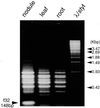
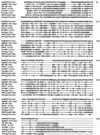
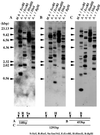
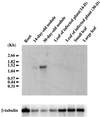
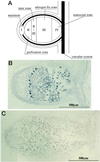
Similar articles
-
Differential gene expression in an actinorhizal symbiosis: evidence for a nodule-specific cysteine proteinase.Proc Natl Acad Sci U S A. 1994 Oct 11;91(21):9891-5. doi: 10.1073/pnas.91.21.9891. Proc Natl Acad Sci U S A. 1994. PMID: 7937912 Free PMC article.
-
Mesorhizobium loti increases root-specific expression of a calcium-binding protein homologue identified by promoter tagging in Lotus japonicus.Mol Plant Microbe Interact. 2000 Jun;13(6):606-16. doi: 10.1094/MPMI.2000.13.6.606. Mol Plant Microbe Interact. 2000. PMID: 10830260
-
A nodule-specific plant cysteine proteinase, AsNODF32, is involved in nodule senescence and nitrogen fixation activity of the green manure legume Astragalus sinicus.New Phytol. 2008;180(1):185-192. doi: 10.1111/j.1469-8137.2008.02562.x. Epub 2008 Jul 15. New Phytol. 2008. PMID: 18643938
-
Symbiosis specificity in the legume: rhizobial mutualism.Cell Microbiol. 2012 Mar;14(3):334-42. doi: 10.1111/j.1462-5822.2011.01736.x. Epub 2012 Feb 3. Cell Microbiol. 2012. PMID: 22168434 Review.
-
Symbiotic host specificity between leguminous plants and rhizobia is determined by substituted and acylated glucosamine oligosaccharide signals.Glycobiology. 1994 Apr;4(2):127-34. doi: 10.1093/glycob/4.2.127. Glycobiology. 1994. PMID: 8054712 Review.
Cited by
-
Transcription Factor bHLH2 Represses CYSTEINE PROTEASE77 to Negatively Regulate Nodule Senescence.Plant Physiol. 2019 Dec;181(4):1683-1703. doi: 10.1104/pp.19.00574. Epub 2019 Oct 7. Plant Physiol. 2019. PMID: 31591150 Free PMC article.
-
Transcriptional responses of Medicago truncatula upon sulfur deficiency stress and arbuscular mycorrhizal symbiosis.Front Plant Sci. 2014 Dec 2;5:680. doi: 10.3389/fpls.2014.00680. eCollection 2014. Front Plant Sci. 2014. PMID: 25520732 Free PMC article.
-
Silencing of the CaCP gene delays salt- and osmotic-induced leaf senescence in Capsicum annuum L.Int J Mol Sci. 2014 May 12;15(5):8316-34. doi: 10.3390/ijms15058316. Int J Mol Sci. 2014. PMID: 24823878 Free PMC article.
-
EFD Is an ERF transcription factor involved in the control of nodule number and differentiation in Medicago truncatula.Plant Cell. 2008 Oct;20(10):2696-713. doi: 10.1105/tpc.108.059857. Epub 2008 Oct 31. Plant Cell. 2008. PMID: 18978033 Free PMC article.
-
Characteristics and Research Progress of Legume Nodule Senescence.Plants (Basel). 2021 May 30;10(6):1103. doi: 10.3390/plants10061103. Plants (Basel). 2021. PMID: 34070891 Free PMC article. Review.
References
-
- Barrett AJ. Cysteine proteinases. In: Dalling MJ, editor. Plant Proteolytic Enzymes. Vol. 1. Boca Raton, FL: CRC Press; 1986. pp. 1–16.
-
- Becker C, Senyuk VJ, Shutov AD, Nong VH, Fischer J, Horstmann C, Muentz K. Proteinase A, a storage-globulin-degrading endopeptidase of vetch (Vicia sativaL.) seeds is not involved in early steps of storage-protein mobilization. Eur J Biochem. 1997;248:304–312. - PubMed
-
- Chen WX, Li GS, Qi YL, Wang ET, Wang HL, Yuan HL, Li L. Rhizobium huakuii sp. Nov. isolated from the root nodules of Astragalus sinicus. Int J Syst Bacteriol. 1991;41:275–280.
-
- Cho HJ, Xu Y, Murooka Y. Formation of adventitious shoots and plant regeneration by culture of cotyledon segment in Astragalus sinicus(Chinese milk vetch) Plant Tissue Culture Lett. 1995;12:87–90.
MeSH terms
Substances
LinkOut - more resources
Full Text Sources

